There is no denying that the 20th century, or at least the second half of it, belongs entirely to the electric guitar. It is responsible for numerous seminal moments in music history, across multiple genres. Indeed, the electric guitar is one of the most versatile instruments out there, and given the right combo of guitar, amp, and pedals/effects, you can pretty much play any kind of rock, blues, jazz, country, or metal tune, just to name a few. It works in any kind of situation, provided that the player is skilled enough. But, it is because of this versatility that it’s sometimes hard to choose the right guitar for yourself.
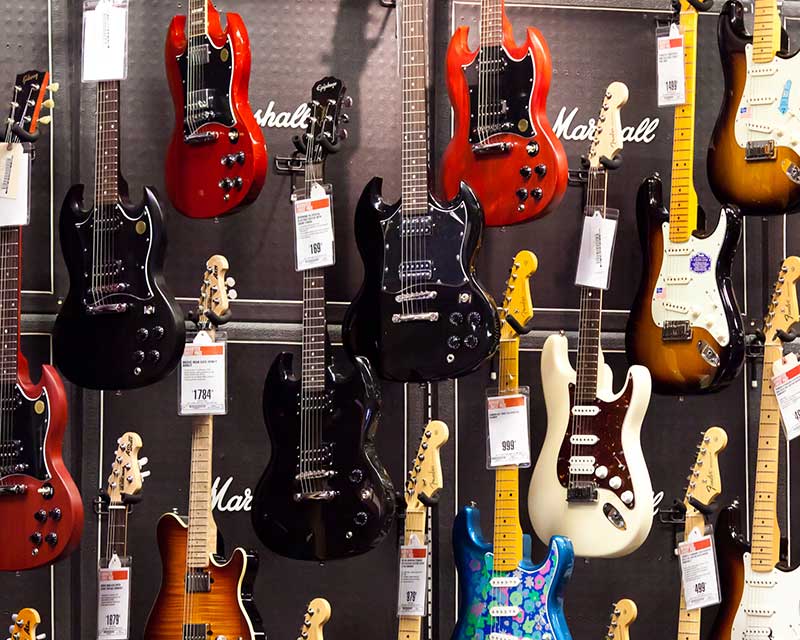
In other words, there are enough brands, models, body shapes, body types, as well as different pickup categories and configurations to make your head spin. Sure, some are instantly recognizable and need no introduction, such as the Stratocaster, Telecaster, or Les Paul, but they are just the tip of the iceberg. To make your choice easier, we have decided to put together a detailed guide on electric guitars, in which we will cover some of the most common types of electric guitars, as well as what makes each of them unique. Keep on reading to find out.
Here Are the Types of Electric Guitars
1. Stratocaster

Fender Stratocaster, along with Gibson Les Paul, is the most iconic guitar of them all. However, because it’s difficult to copyright just the guitar shape, there are plenty of other guitar manufacturers that build Stratocaster-style electric guitars. Apart from selling Strats under their own brand, Fender also manufactures and sells affordable Stratocasters under the Squier name, which is a subsidiary of theirs. You will also come across brands such as Suhr, G&L, and even PRS, which have their own Stratocasters.
The original Stratocaster was built and launched in 1954 by Leo Fender himself and has gone on to become the very essence of electric guitar, and it’s arguably the coolest-looking guitar of all unless you ask the guitar players who prefer the Les Paul. Since the Les Paul came out before the Stratocaster, Leo Fender and his team worked hard on creating a guitar that was going to go up against Gibson, but with a radically different design. The most distinctive thing about the Strat, apart from the sound, is its body shape.
Whereas the Les Paul initially introduced a single-cutaway body (double-cutaway Les Pauls have been offered since), the Stratocaster features a double-cutaway design, so that players can access those uppers frets using not only their fretting fingers but their thumb as well. Unlike the Les Paul, which has three tuning pegs on each side of the headstock, the Stratocaster has six inline tuners. Finally, the Strat has three single-coil pickups, as opposed to two humbuckers which can be found on a Les Paul. Of course, there are Strats which have both, but we are talking about the default Stratocaster configuration.
The three-pickup setup was designed by Leo Fender not only as a way to distinguish the Stratocaster from its main competitor but also as a way of providing guitar players with a wider selection of tones and sounds. Single coil pickups are known for their brighter, thinner sound, but when combined, they can produce anything from crunchy rhythm tones to smooth, creamy solos, as well as that signature Stratocaster twang that has made this guitar so desirable. Although originally manufactured with a three-way selector switch, modern Strats usually have a five-way switch, which allows for “in-between” sounds.
The Stratocaster is also known for its tremolo bridge, which is a spring-loaded mechanism that allows the player to change the pitch of the note or the entire chord using the tremolo arm, also known as the whammy bar. There are different ways in which you can change the pitch of the note, whether it’s by shaking the bar or simply bending it back and forth. The player which has really taken the use of tremolo to a whole new level is Jeff Beck, which uses it for both dramatic effects and delicate, subtle notes.
In terms of construction and materials, Stratocaster bodies are usually made out of basswood, in case of affordable models, to those which are made of alder or ash. For the neck, Stratocaster necks are nearly always maple, whereas the fretboard is either rosewood or maple. Also, the necks are always bolted onto the guitar body. One thing all players agree on it’s that the Stratocaster is comfortable to play and hold, since it’s not as heavy as a Les Paul, and features plenty of body contouring. A little known fact is that the characteristic Fender Stratocaster headstock was inspired by the headstock of the tamburitza, which is a stringed instrument found in Serbia, Croatia, and their neighboring countries.
When it comes to genre, the Stratocaster is a pretty versatile guitar, although its tone is usually associated with the blues. And sure, the Strat sounds great when you play it clean or when you use low gain, and because of those clear treble notes, it easily cuts through any kind of mix. However, it is equally brilliant when you want to play loud rock and roll and hard rock with plenty of gain, jazz, funk, pop, country, punk, or rhythm, and blues. In case you want to use it to play metal, you might be better with a Strat which utilizes humbucker pickups, or a Superstrat, which we will get to in the next section of this guide.
Given its legendary status, the Stratocaster has been played by numerous guitar players and virtuosos, including Jeff Beck, Jimi Hendrix, Eric Clapton, Ritchie Blackmore, Rory Gallagher, Stevie Ray Vaughan, David Gilmour, Eric Johnson, Mark Knopfler, Buddy Holly, Robin Trower, Hank Marvin, Buddy Guy, Eric Gales, John Frusciante, and Yngwie Malmsteen, among others.
2. Superstrat
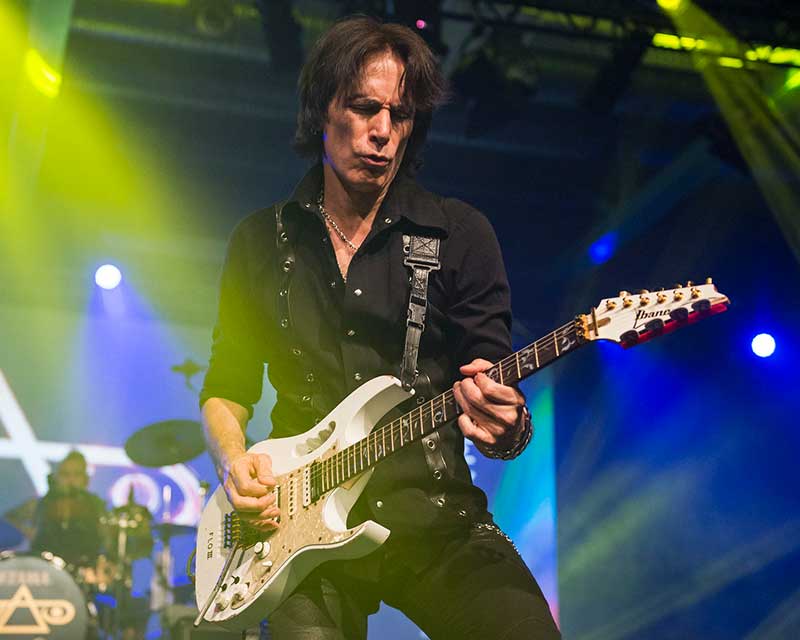
Superstrats are modern guitars that are designed as a variation of the good old Stratocaster. But, even though they share some similarities at first glance, they are very different instruments in the way they are played and designed. They somewhat resemble Strats, but with a deeper and “pointier” cutaway. These deeper double cutaways are there for a reason because they allow for easier access to upper frets. It’s not uncommon for Superstrats to have more frets than the regular Stratocaster, as well as seven or eight strings, and those deeper cutaways come in handy.
Since Superstrats are predominantly used by metal guitarists and shredders, they also feature larger frets, as well as slimmer and flatter necks which allow for faster playing and soloing that is very common in heavy metal. Another reason why Superstrats are usually used in metal are their pickups, which have a higher output when compared to single-coil pickups, and because these guitars usually utilize humbuckers, which makes it very easy for you to overdrive the amp. Superstrats are versatile guitars, but the aforementioned qualities make them extremely desirable among players of those genres.
Another difference between Superstrats and your regular Stratocaster is that Superstrats have a different type of tremolo system. What they have is a locking-type tremolo system, which minimizes the tradeoff on Stratocasters. What kind of tradeoff? Well, the tremolo system on Strats makes it easier for the guitar to go out of tune. Superstrats, on the other hand, have Floyd Rose tremolos, which not only allow for a better range of movement, but they also allow the guitar to stay in tune for longer, despite all the fretboard pyrotechnics.
Superstrats can be found inside the ranges of numerous guitar manufacturers, including Yahama, ESP, Ibanez, Jackson, Dean, Schecter, Charvel, and Washburn, just to name a few. Because they use high output pickups such as humbuckers, these guitars have a different sound than the Strat, which means there is none of that familiar mid-range twang. One thing that Superstrats do share with the Stratocaster is their modularity since the original Strats enable you to replace some parts of the guitar, such as pickups or even the neck, which can be easily done, since they are bolted onto the body. The whole concept of a Superstrat came about thanks to modifications done to the Stratocaster by none other than Eddie Van Halen. There is even an EVH line of guitars.
Superstrats have also influenced the manufacturers of Strat-type guitars, since some of the modifications that are native to Superstrats, such as the Floyd Rose tremolo system humbuckers, can be found on stock Stratocaster models now, even on those which are made by Fender. For example, it’s not uncommon to see a Fender Stratocaster which has a humbucker replacing the bridge pickup. Currently, you can choose between the following configurations of humbucker and single coil pickups: HSS, HSH, and HH. Fender Stratocasters which have at least one humbucker pickup are also known as “Fat Strats” because the sound they produce is “fatter” when compared to the thinner, trebly sound produced by single-coil pickups.
Superstrats emerged and were hugely popular in the ‘80s because metal and shredding were so big back then. During the ‘90s, they have somewhat faded from the spotlight, due to the rise of alternative rock and grunge, which rejected the virtuosity and polished sound of the previous decade. However, they have come back, and they are as popular as ever and remain the guitar of choice for metal guitarists everywhere. Some of the most notable Superstrat players are Eddie Van Halen, Steve Vai, Kirk Hammer, Michael Angelo Batio, Joe Satriani, Paul Gilbert, and Dexter Holland.
3. Telecaster
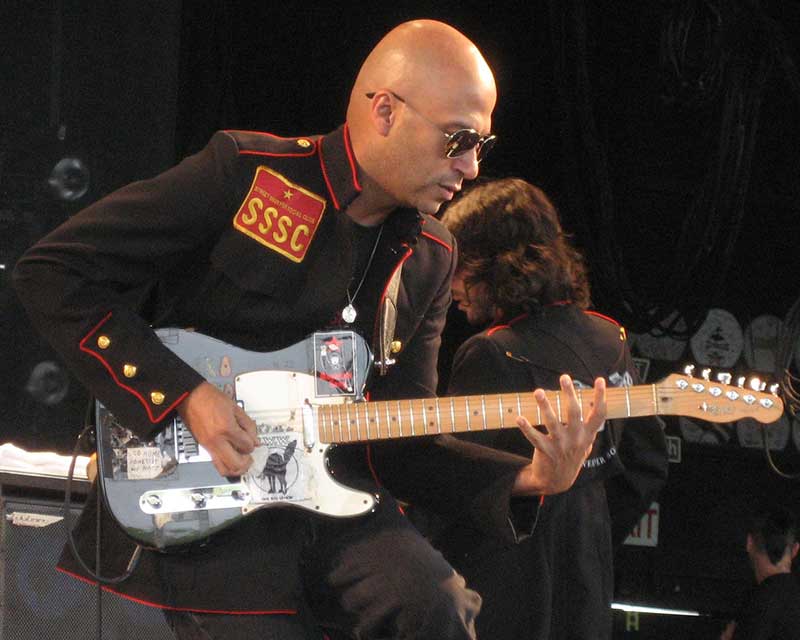
Another iconic guitar by Fender, the Telecaster, or simply Tele, is the first successfully mass-produced electric guitar. It was introduced back in 1951, only a few years before the Strat, and has gone on to become one of the most popular guitars in history. If you are a fan of the famous Stratocaster twang, you will love the Tele even more, since that sound is even more pronounced here. It was the reason why the Telecaster was so popular among country and indie players, before being discovered by blues, funk, and rock crowds. If properly set up, the Telecaster can even be used to produce a more aggressive sound, as well as tones which you wouldn’t expect from a Telecaster, as is evident by Tom Morello’s use of this particular guitar.
Although the Telecaster is hugely popular, it is strange to find that its shape and design haven’t been replicated by a lot of guitar manufacturers, which was the case with the Stratocaster and Les Paul. Apart from cheap copies made by lesser-known companies, Telecaster guitars are predominantly made by Fender and Squier. When it was originally released, the Telecaster was known as the Broadcaster, until Fender got sued, because there was an existing drum kit model called the Broadkaster.
In addition to its vintage look with a single cutaway, the Telecaster also has a few more unique characteristics. Although you can find Telecasters that use humbuckers or Strat-style pickups, they usually have two single-coil pickups and a three-way selector switch. What’s unique to the Telecaster is that the bridge pickup is slightly angled, while the neck single coil pickup has a lipstick cover. Another thing you will also see on most Telecasters is the “ashtray” bridge, which got its name because the players used to remove the metal bridge cover and use it as an ashtray. Instead of a setup that uses six steel saddles, the Tele has three brass saddles, which contribute to the thinner, twangier sound of the guitar.
Unlike the Strat, the body of the Telecaster has almost no contouring, apart from the single cutaway. As in the case of the Stratocaster, different types of tonewoods are used, depending on the price bracket. In nearly all cases, the neck is made from maple and is bolted onto the body. Fretboards are either rosewood or maple. The most notable players which are associated with the Telecaster are Bruce Springsteen, Keith Richards, Roy Buchanan, George Harrison, Jeff Buckley, Tom Morello, Muddy Waters, Prince, Danny Gatton, and Freddie Stone, among others. Telecaster is one of the most common types of electric guitars and you will see it often.
Related Article: The Diffent Types of Acoustic Guitars
4. Les Paul
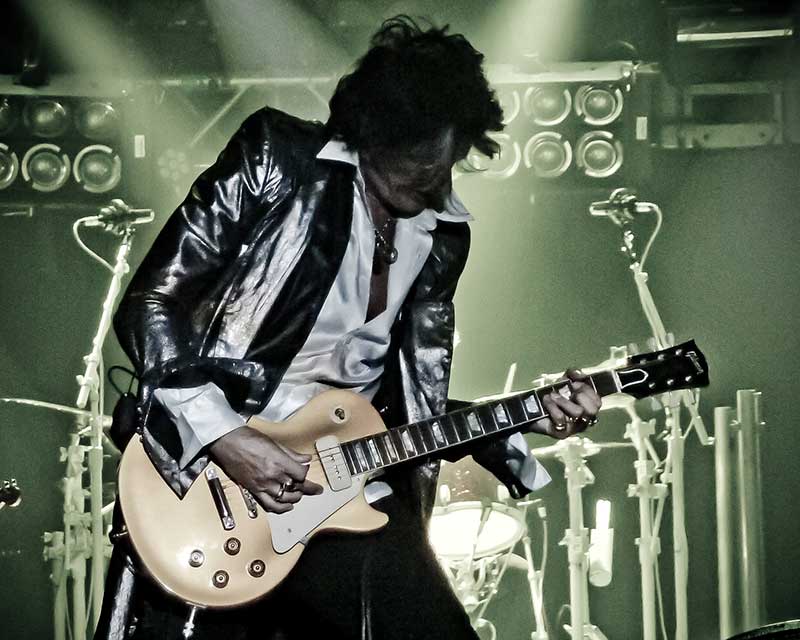
Gibson Les Paul is, according to many, the most iconic electric guitar in music history, along with Fender Stratocaster. The Les Paul electric guitar was designed in collaboration with the legendary jazz guitarist Les Paul after the famous Gibson president Ted McCarty reached out to him and asked for his input because Gibson was looking to build its first mass-produced electric guitar. And the rest was history. The Les Paul is not only iconic, but it’s also one of the most versatile guitars out there. It allows you to play anything from smooth jazz chords and soaring classic rock solos, to punk rock power chords, metal, and everything else in between.
The only genre for which it might not be the best choice is country since it doesn’t have that twang that is usually produced by Telecasters and Stratocasters. Perhaps its most at home in classic and hard rock, because of its massive sustain, balanced response, and somewhat darker, richer high-end. It’s the kind of tone that you would hear listening to Jimmy Page on pretty much any of the Led Zeppelin songs, or Slash in any of the bands he has been in, from Guns N’ Roses to Velvet Revolver.
Even though the Les Paul is synonymous with humbucker pickups, the first Les Paul models were fitted with single-coil pickups, which prompted Leo Fender to one-up Gibson by releasing the Fender Stratocaster with three single-coil pickups. However, by the time the ‘60s came around, all Gibson Les Pauls were fitted with two humbucker pickups, with a few exceptions here and there. Although Gibson has been pretty quick to sue various guitar brands, that hasn’t stopped guitar manufacturers such as Dean, Ibanez, and ESP from making their own versions of the Les Paul, or in the case of PRS, coming up with their own take on the original.
One of the reasons why Les Pauls aren’t as easily obtainable, especially for beginners, is because of the higher price tag. The reason why Gibson Les Pauls are more expensive is that they are made exclusively in the US, whereas Stratocaster and Telecaster are, apart from the US, also made in Japan and Mexico, under the Fender name. But, for those which are looking for that signature, fat Les Paul tone, Gibson sells more affordable Les Pauls under the Epiphone name.
In terms of materials, Gibson Les Paul bodies are usually made out of solid mahogany, with a thinner layer of maple, which is responsible for those beautiful flame tops. In terms of contouring, Les Pauls come in a variety of versions, from those that have a very arched top to those that are nearly flat. Les Paul guitars also have a set neck, which means they are glued to the body of the guitar, which makes the guitar stronger and gives it better sustain. However, if you want to replace the neck, the process is much more complicated than that on the Strat guitars, since they have a neck which can be easily removed or bolted onto the body.
Although there are double-cutaway Gibson Les Pauls, the most recognizable shape is the single cut. Most Les Pauls also feature a Tune-O-Matic bridge with Stop Bar tailpiece. Other common characteristics include the trapezoid inlays on the fretboard, which can be either rosewood or ebony, painted headstock, as well as binding on the neck and around the body of the guitar. All of those elements, along with the fact that it’s made in the US, contribute to the higher price tag, but the result is an electric guitar with superb craftsmanship and tone.
Les Paul has been played by numerous guitarists which have made it legendary, and vice versa, including Jimmy Page, Slash, Gary Moore, Buckethead, Joe Walsh, Zakk Wylde, Frank Zappa, Pete Townshend, Joe Bonamassa, Billy Gibbons, Peter Green, Peter Frampton, and Paul Kossoff.
5. SG

Gibson SG, in a way, is Gibson’s equivalent of the Telecaster, since it is their second most iconic guitar. But, it may also come as a surprise that the SG is Gibson’s best-selling guitar of all time and not the Les Paul. Introduced back in 1961, it was supposed to be a significant redesign of the Les Paul, which was selling less and less. However, Les Paul, the guitarist, didn’t like the design, and he didn’t want his name attached to it, so it was marketed as an SG.
The body of the SG is made out of mahogany and features two cutaways and a set neck with 22 frets. Because both the body and neck are very slim, it allows for faster playing, which is why it’s popular among rock and metal players, and more recently, among stoner rock and stoner metal bands, which couple it with fuzz pedals. In terms of hardware, it is similar to the Les Paul, with two humbuckers and a Tune-O-Matic bridge. When it comes to sound, it’s full and warm, but with a lot more bite than the Les Paul. Notable players include Angus Young, Tony Iommi, Jerry Garcia, Derek Trucks, Daron Malakian, and Thom Yorke.
Related Popular Article: The Best Electric Guitars for Beginners
6. Flying V
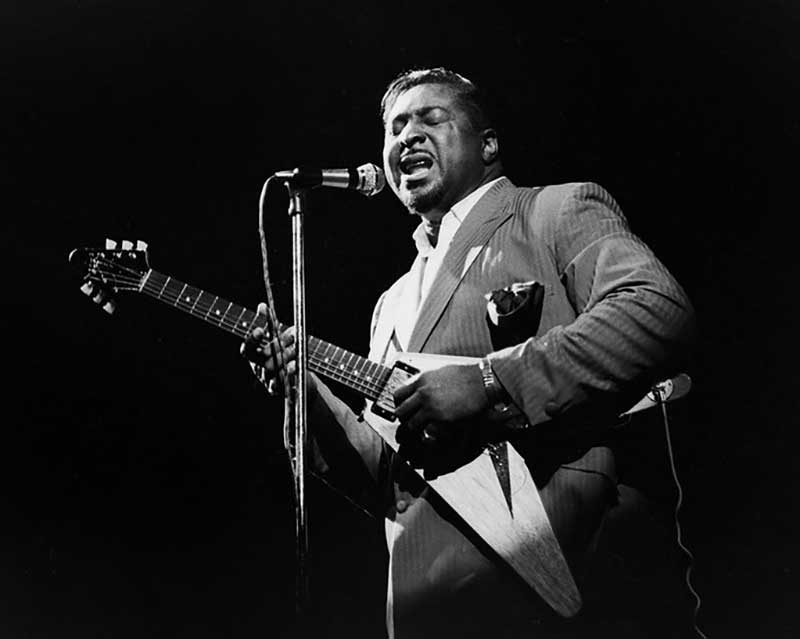
Gibson Flying V was introduced back in 1958, and its futuristic looks didn’t help it win over fans immediately, and it was nearly pulled from production for good until it was played by the likes of Jimi Hendrix and Dave Davies. One of the best things about the Flying V is that it’s so easy to access those upper frets from both sides since there is no body or horns to get in the way. On the other hand, this makes it somewhat imbalanced and less comfortable. There is also the Reverse Flying V, which is even more eye-catching and unusual.
In terms of hardware, tonewoods, and tonal characteristics, it is very similar to the Gibson SG. The layout of the pickups is similar as well. It features one neck humbucker pickup and one bridge humbucker pickup. Notable guitar players which have used the Flying V are James Hetfield, Kirk Hammet, Jimi Hendrix, Dave Davies, Lenny Kravitz, Tim Wheeler, Albert King, Dave Mustaine, Marc Bolan, Steve Jones, Lonnie Mack, and Billy Gibbons.
7. Offset Guitars
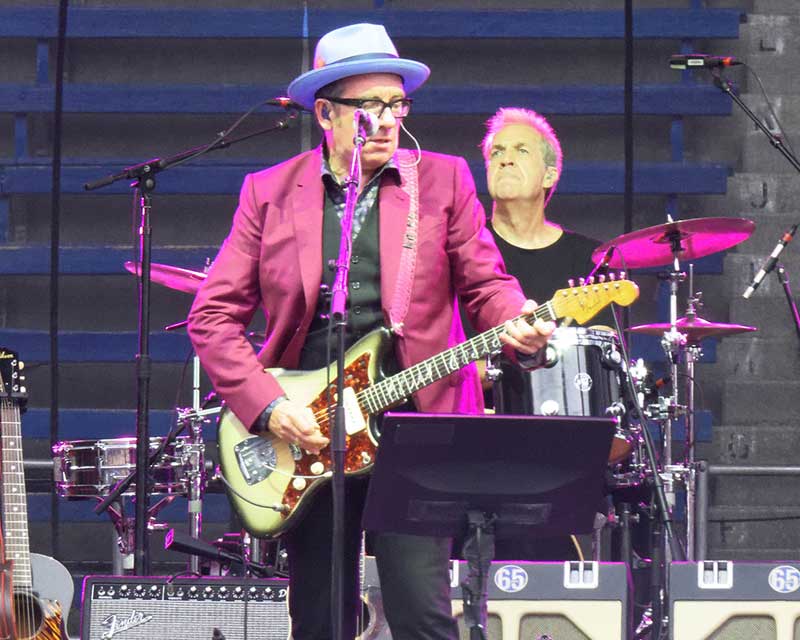
While the term “offset” is usually used to characterize something uneven or unbalanced, in the context of electric guitars, it is used to describe guitars whose upper and lower half of the body are asymmetrical, with curves on one side being more pronounced than on the other. This doesn’t apply to guitars which have cutaways but are otherwise symmetrical. Fender and Gibson have several offset electric guitars in their range. For instance, Fender offers the Jaguar, the Mustang, the Duo-Sonic, and the Jazzmaster. Gibson, on the other hand, has the Explorer and the Firebird. Other brands that have come up with their own take on the offset shape include PRS, Reverend, Ibanez, Duesenberg, and G&L.
Although the three Fender offset guitars are different from one another, they have some similarities, the chief of which is their sound, which is very bright and clear, with mids and low-end that is not overly pronounced. This makes them ideal for alternative rock genres, where they are often used with different pedals and effects. Another reason why they were so popular among the Seattle grunge bands was their affordability since they didn’t cost nearly as much as Strats or Les Pauls. Kurt Cobain was often seen playing the Fender Jaguar. Notable players, apart from Kurt Cobain, include Rory Gallagher, David Byrne, Patti Smith, Elvis Costello, Todd Rundgren, John Frusciante, and J Mascis.
As far the Explorer and the Firebird are concerned, they belong in the same category as the Flying V, at least when it comes to futuristic design and easy access to upper frets. The Explorer also features the same kind of humbucker configuration. The Firebird, on the other hand, is a bit different from its banjo-style tuners and mini humbuckers, which produce a different sound than those found on the SG, Flying V, or the Explorer. Its shape resembles an Explorer, with somewhat rounder and softer features. Gibson offset guitars have been played by the likes of Mick Taylor, Allen Collins, Johnny Winter, Scott Holiday, and Dave Grohl.
Related Article: Easy Guitar Solos for Beginners
8. Semi-Hollow Body Electric Guitars
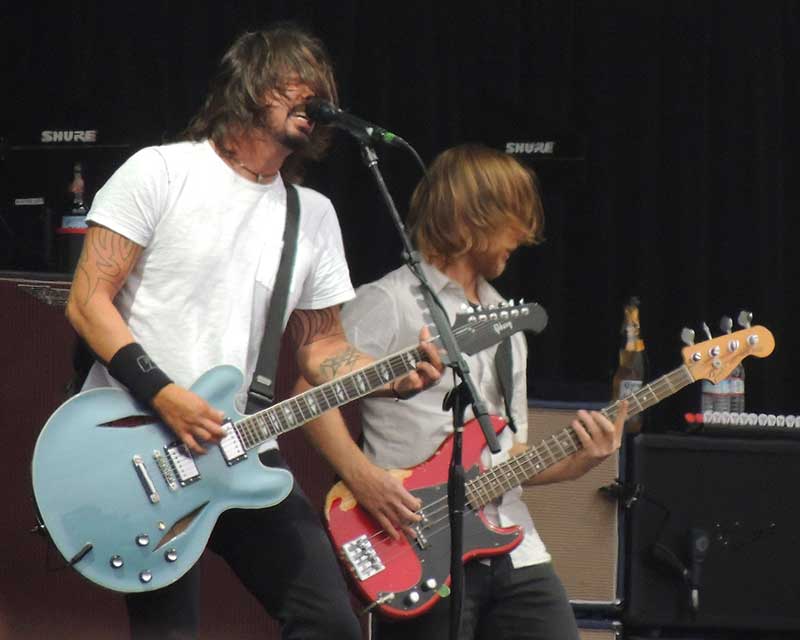
Semi-hollow electric, just like their name indicates, are partially hollow on the inside. Usually, the inner chamber of the guitar is divided into two parts by a wooden block that runs along the body of the guitar, right underneath the pickups. The semi-hollow body makes for a sound that is very responsive and warm. In terms of shape, their bodies are usually bigger than those of solid guitars, with single or double cutaways, and they might also sport f-holes, similar to those found on violins. Semi-hollow bodies also have good sustain and are more resistant to feedback.
Although they are a natural fit for genres like jazz and blues, lots of guitar players, especially those which are leaning toward a vintage sound, are opting for semi-hollow guitars. Although Rickenbacker was the first guitar manufacturer to produce a semi-hollow guitar, other companies, such as Gibson and Gretsch, have made it more popular. Gibson’s flagship semi-hollow body guitar is the ES-335, while Gretsch has a huge range of semi-hollow guitars, most notably the G6659TG.
Because of the sweet tone and sustain, they have been played by many famous guitar players, including B.B. King, Alvin Lee, Larry Carlton, Chuck Berry, George Benson, Dave Grohl, Chris Cornell, Jack White, Otis Rush, Warren Haynes, and Dan Auerbach.
9. Hollow Body Electric Guitars
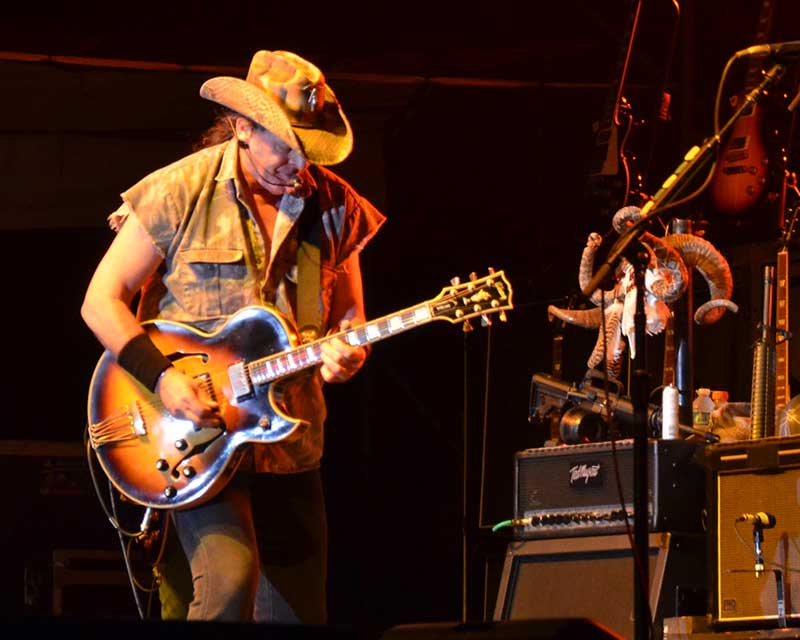
Although the first thing everyone thinks about when someone mentions hollow-body guitars are big jazz guitars, they encompass other types of guitars, as well. Yes, there are large jazz guitars with deep, hollow bodies and thin necks which allow for smoother chard changes, and they are known as jazz box style guitars. The most notable example is the Gibson ES 175. The second type of hollow-body guitar are guitars which have an ES-355 body style. The main similarity between these two styles is the lack of a wooden block that runs down the middle of the guitar. They are, therefore, hollow-body instruments.
While semi-hollow body guitars have a tone that has some acoustic nuances to it, those nuances are much more pronounced on this type of guitar. However, unlike their semi-hollow counterparts, hollow-body guitars are very prone to feedback, which makes them less suitable for genres that require high gain, such as rock or even blues. However, there are examples, such as the Gibson Byrdland, which has been used by Ted Nugent because of its proneness to feedback, in order to create a particular sound. But, in most cases, their acoustic-like tone makes them ideal for jazz. Other popular models are guitars from Gretsch Streamliner and Ibanez Artcore series.
They are also known as archtop guitars since they have arched tops, as well as the back. Although the top and back on high-end hollow-body guitars are each made out of a single piece of wood, the more affordable models are built using laminate wood. Unlike solid body or even semi-hollow body guitars, these guitars can be used without an amp, since their body allows them to resonate, although they still work best when amplified. Notable players, in addition to Ted Nugent, include George Benson, Pat Metheny, and Steve Howe.
Related Article: Easy Beginner Guitar Songs
Electric Guitar Classification Summary
There are so many different sounds you can get out of an electric guitar with the right combination of tone and volume controls, pickups, as well as amps and effects. For the purpose of this article, we focused on the most common types of guitar categorization: according to body style, and pickups.
When it comes to body style, we can easily tell apart three different types of electric guitar:
- Solid-Body
- Semi-Hollow Body
- Hollow-Body
Things may not be as versatile when it comes to pickups, but in most cases, you will still find one of these three types of pickups on electric guitars or a combination of the two or more:
- Single-Coil
- Humbucker
- P90
We will also briefly touch on some other factors which contribute to the sound/playability, such as tonewoods, as well as neck shape and the way it is mounted on the guitar.
Types of Electric Guitar Pickups
Regardless of what sort of body style you prefer, it is not going to necessarily determine the sound of your guitar. Some say that tonewoods play a big role, but that is a controversial subject among electric guitar players, so we will leave that for another article. Pickups, on the other hand, do play a huge role, which is evident if you take a look, for example, at Stratocasters with humbucker pickups instead of the single-coil ones. That being said, these are the three most common types of pickups you will come across on electric guitars:
Single Coil Pickups
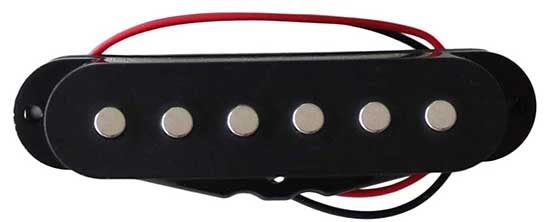
The earliest electric guitars were fitted with single-coil pickups, and they still remain a popular choice for many, especially those which prefer Stratocaster and Telecaster-style guitars. Why are they called single coils? Because they only have one coil of wire. Not all single coils pickups are the same. Some can have a single magnet, others may have screws that enable you to adjust the pole pieces, or they may have a separate magnet for each string. Regardless of the construction, all pickups which have a single coil of wire are single-coil pickups.
Single coil pickups have a very distinctive sound which is very bright and clear, which is great for many applications, especially when it comes to genres like rock, blues, and jazz. One of the reasons why they are suitable for heavier genres, such as metal, is because they have lower output, and therefore aren’t able to produce as much distortion as humbucker pickups. They work best if they are played at lower gain. Another tradeoff is their ability to pick up on electromagnetic radiation from their environment, much like an antenna. Computer screens, outdoor lighting, and even wiring can cause single-coil pickups to produce hum.
Humbucker Pickups
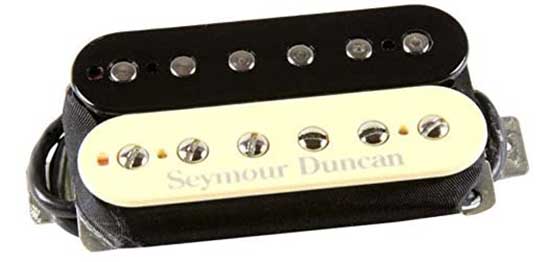
Another brilliant move by Ted McCarty was to assign Gibson engineers with a job of designing pickups that would be less prone to capturing electromagnetic radiation and hum. In 1995, they came up with pickups that used two coils of wire instead of one which was capable of canceling, or “bucking” the hums, hence the name humbuckers. Apart from using two coils of wire, humbuckers utilize either two (sets of) magnets or pole pieces that are placed on the opposite ends of a magnet. Things get pretty technical here, but what you need to know is that two wire coils are wound with opposing electrical, as well as magnetic polarity and that each coil carries two signals.
The first signal is the sound that comes from vibrating strings, and the second is the noise that stems from the 60-cycle hum, which is canceled. Humbucker pickups have a higher output which can produce a lot of distortion, and they also sound warm and smooth, which makes them ideal for hard rock and metal but also jazz and blues. Most Gibson guitars, such as the Les Paul, Explorer, Flying V, and the SG, feature two humbucker pickups, although you will also come across Fender Stratocasters and Telecasters which have at least one humbucker pickup. Humbuckers are also used by PRS, ESP, Ibanez, Yamaha, and just about every other guitar manufacturer out there.
P90 Pickups
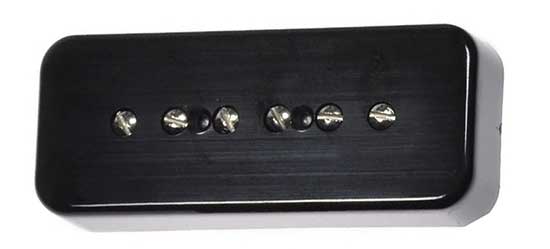
P90 pickups look and sound like the middle ground between single-coil and humbucker pickups. They are somewhere in between in terms of size, and in terms of sound. Their output is higher than that of single-coil pickups but not as high as the output of humbuckers. While they do sound brighter than humbuckers, they are not as clear and transparent as single coils. P90 pickups can be categorized into three different types according to their casing:
Soap Bar Casing
This type of P90s has a rectangular casing that resembles a soap bar. The dots that can be seen on the casing are usually mistaken for pole pieces, but they are actually mounting screws that are placed in between the pole pieces. Fun fact: early Les Pauls had P90 soap bar pickups which were white.
Dog Ear Casing
These come in a variety of colors, and although similar in proportions to soap bar P90s, the dog ear pickups have extensions on both sides, which are there to hold the mounting screws in place. They are usually found on hollow-body guitars, such as the Gibson ES-330. Although they are not as common on solid body guitars, some models, such as the Gibson Les Paul Junior, still have them. Another notable electric guitar to feature dog-ear P90 pickups is the Epiphone Casino.
Humbucker Casing
One of the issues of changing the guitar pickups is the fact that each guitar is routed for a specific type of pickup. This means that, even though you can put a single-coil pickup on a Les Paul, the result will not only look subpar, but it may cause some structural problems. The same goes for P90 pickups if you want to mount them on a guitar which originally had humbuckers since there is a difference in size and shape of both the pickups and the rout. The good news is that you can get the P90 pickups that come in a humbucker-type casing that fits the humbucker route.
And that is all you need to know about electric guitars in order to get started. We hope that this guide has shed some light on a somewhat confusing subject and that it will help you pick out the right guitar for yourself. Good luck!

My name is Chris and I’ve had a passion for music and guitars for as long as I can remember. I started this website with some of my friends who are musicians, music teachers, gear heads, and music enthusiasts so we could provide high-quality guitar and music-related content.
I’ve been playing guitar since I was 13 years old and am an avid collector. Amps, pedals, guitars, bass, drums, microphones, studio, and recording gear, I love it all.
I was born and raised in Western Pennsylvania. My background is in Electrical Engineering, earning a Bachelor’s degree from Youngstown State University. With my engineering experience, I’ve developed as a designer of guitar amplifiers and effects. A true passion of mine, I’ve designed, built, and repaired a wide range of guitar amps and electronics. Here at the Guitar Lobby, our aim is to share our passion for Music and gear with the rest of the music community.
